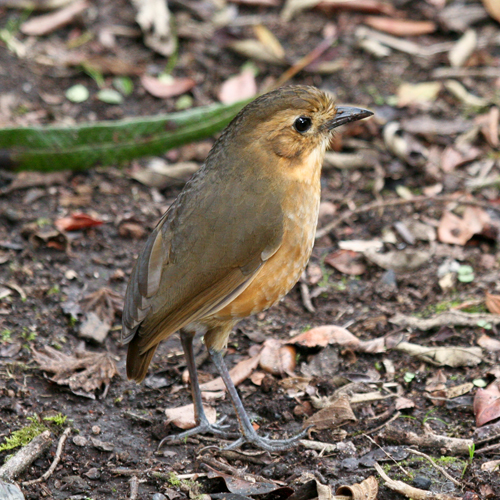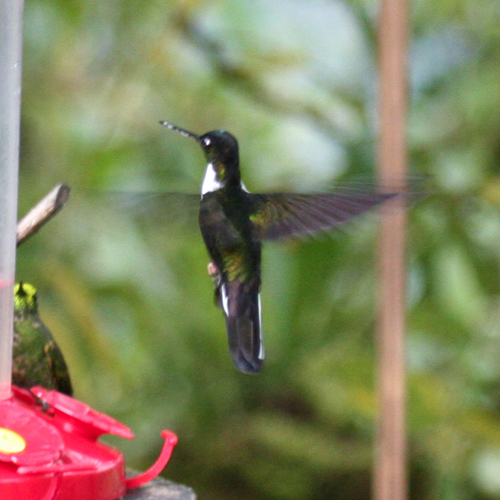Barbara and I have considered going to the Galapagos Islands for several years, but we put it off until this fall. We decided to go now because in February, 2012 new rules will reduce by half the number of landings that cruise vessels can make on a 7-day cruise. We decided to go a few days early to see Quito and to get in a day of birding in the Andes near Quito.
We arrived in Quito on the evening of October 27th. We were met at the airport by a driver sent by our hotel, the Mercure Alameda. Our room at the hotel was clean and spacious, but extremely noisy all night. We endured it for 2 nights but finally had to ask to be moved to an interior room for our last night so that we could get some sleep. After a bit of difficulty at the desk, the manager found us an interior room and we were very grateful for the quietude that it gave us for our final night. Prospective guests of this hotel should be very sure to request an interior room if they hope to get a good night’s rest.
On Friday the 28th we walked from our hotel to the Old City to see the historic buildings. Some have doubted our wisdom in walking in this area but it appeared to us to be quite safe, at least in daylight. We visited the Basilica. The interior is quite stark and the windows are beautiful. We then walked on to the Presidential Palace and the surrounding square. There were many people on the streets. Among the more interesting sights was the open-air flower market. The variety and colors were amazing. I cannot imagine how all of those flowers get sold, but it appeared that local customers were buying.
We went on to the Plaza San Francisco and entered the ornately gold-decorated church, where mass was in process. We stayed for the mass. At the side of the church was a café with outdoor seating and we enjoyed a lunch including the local specialty soup: potato, goat cheese, avocado, and other unrecognized ingredients. From there and from other sites along our route we could see the statue of the winged Virgin of Quito high above the city. All things considered we were glad that we had spent the day walking around the Old Town. It was a very interesting day.
At 5:30 the next morning we were picked up at the hotel by bird guide, Juan Carlos Crespo, and his driver. Juan Carlos works as a guide for Bella Vista Preserve, a remote natural area which is a long, rough drive from Quito if you go by the Nono Road, which we did, and a short, smooth, 2 hour drive if you take the main highway, which we did upon our return. The Nono Road is famous among birders for its variety of birds. The first stop was at the Yanacocha Reserve. There we took a long walk along an easy mountain path. The most numerous families of birds in this area are the hummingbirds and the tanagers.
The hummingbird species seen well on this walk were: Shining Sunbeam, Great Sapphire Wing, Buff-winged Star Frontlet, Sword-billed Hummingbird (very striking),

Sapphire-vented Puffleg, Golden-breasted Puffleg, and Tyrean Metal-tail. Along with the hummingbirds were quite numerous Masked Flower Piercers and Glossy Flower Piercers, which often compete with the hummingbirds at the hummingbird feeding stations along, and especially at the end of, the path.
Tanagers seen here were: Scarlet-bellied Mountain Tanagers, Hooded Mountain Tanager, Black-chested Mountain Tanager, Rufous-naped Brush Finches,

and Golden-crowned Tanagers.

We were surprised and pleased when a Barred-winged Nightjar flushed from nearly under our feet. We were also able to watch a Tawny Antpitta at close range at the Ranger Station.

The resident Ranger has been tempting it with tidbits of food and he was kind enough to spend some time with us to call the bird out of the brush so that we could get some close-up views.
The other birds we saw at Yanacocha were: Andean Guan, White-banded Tyrannulet, Smoky Bush Tyrant, Great Thrush, Brown-bellied Swallows, Rufous Wrens, Spectacled Whitestarts, and Cinereous Conebill. Birds not seen but recognized by their calls were Ocellated Tapaculos, Curve-billed Tinamous, and the Owl-imitating Giant Antpittas.
We left Yanacocha after a couple of hours and proceeded on the Nono Road toward Bella Vista Preserve. Along the way we saw a pair of Andean Lapwings with a young chick. The country side is beautiful and rugged. Cattle farming seems to be the main livelihood of the few folks that live along the way. The Paramo was lovely in the morning mist and sunlight.
We had a good lunch at Bella Vista and then spent a couple of hours on the premises. Again, the hummingbirds were the main attractions, including: Green Violetears, Sparkling Violetears, Andean Emeralds, Rufous-tailed Hummingbirds, Speckled Hummingbirds, Fawn-breasted Brilliants, Collared Incas,

Buff-tailed Coronets, Gorgeted Sunangels, a striking Violet-tailed Sylph, and Purple-throated Woodstars.

Other species seen at Bella Vista were: Band-tailed Pigeons, a strangely disguised Common Pootoo,

Crimson-mantled Woodpeckers, Montane Woodcreeper, Azara’s Spintetail, Streaked Tuftedcheek, Green and Black Fruiteater, Blue and White Swallows, Grey-breasted Wood Wren, Red-eyed Vireo (Yup!! The same as ours), Russet-crowned Warbler, Blue-winged Mountain Tanager, Rufous-collared Sparrow and more Masked Flowerpiercers.
We enjoyed Juan Carlos’ company and were impressed with his knowledge of the Ecuadorean birds. We would recommend him to others looking for a day or more of interesting birding in the Quito area. He is currently on the staff at Bella Vista.
We arrived back at the Hotel about 6:00 p.m. and after a good night’s sleep, flew off to our main destination, the Galapagos, by way of Guayaquil. The next installments will summarize our experiences in the Galapagos.
